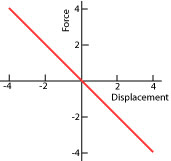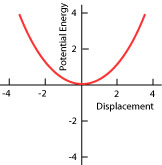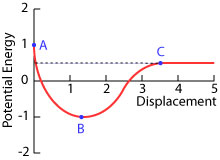| Practice Test | Study Guide |
|
Objectives |
||||||||||||||||
| Essential Question: Can energy be defined? | ||||||||||||||||
|
The Nature of Work
Metacognition Problem Solving Principle: While work is a scalar, it does have a relationship to spatial dimensions. Note that the components of forces and displacements in the same dimension do work. components in a different dimensions do not. This relationship is most evident when multiplying the i j k form of the vectors. Homefun: Questions 1-10 odd p 188; Problems 3, 5, 7 p. 189
Relevance: Mechanical energy is the most useful form. Its availability from a source other than muscle power has profoundly influenced every aspect of human existence.
|
||||||||||||||||
|
Activities |
|
Lesson 1 Key Concept: Work is the mechanical energy transfer done by a force acting through a displacement in its same dimension. Purpose: Use work as a powerful problem solving tool. Interactive Discussion: Objectives 1-8. Note that net positive work tends to increase kinetic energy and net negative decrease it. Demo 7.1: Student holding a book. Is work being done? In Class Problem Solving: How much work is done by the superman force in each of the following:
Interactive Discussion: Objectives 9. Total work is the sum of the dot products in all the dimensions. In Class Problem Solving:
Interactive Discussion: Objectives 10, 11. Derive the spring potential energy equation. Resources/Materials: |
| Essential Question: How are kinetic energy and work related? |
The Nature of Kinetic Energy
- Define kinetic energy 2 ways
- In words: the work needed to accelerate an object from rest to its current velocity. (The energy an object possesses due to its motion)
- Mathematically: K ≡ 1/2 mv2
-
Derive the equation for kinetic energy from the equation for work, Newton's second law, and the kinematic equations assuming constant force and acceleration.
-
Explain the difference between positive and negative work.
- Negative work: reduces kinetic energy. Done by a conservative force such as gravity converts kinetic energy into potential energy. Done by sliding friction converts kinetic energy into thermal energy (heat).
- Positive work: increases kinetic energy
- Use the definition of kinetic energy and work in problem solving.
- Sliding Friction: negative work = heat
- Gravity Force: positive work = kinetic energy
Homefun: Read 7.5, Problems 17, 29, 31 p. 189-190 Serway

- Read: Insultingly Stupid Movie Physics
- Chapter 11, High Energy Films: Nuclear Firecrackers, Falling people, and cars as weapons, pp 163- 179
|
Lesson 2 Key Concept: Kinetic energy and work are related Purpose: Understand that work is mechanical energy transfer and that typically when work is done it either increases or decreases kinetic energy. Interactive Discussion: Objectives. In Class Problem Solving :
|
|
Mini-Lab Physics Investigation (Requires only Purpose, data, and conclusion) |
|
| Title | Pendulum /energy Lab (groups of three) |
| Purpose | Determine if a pendulum can be considered frictionless. |
| Overview | The law of conservation of energy (1st law of
Thermodynamics) is as close to absolute truth as anything in all
of science. If a pendulum can be considered frictionless then
the potential energy at the top of the swing will exactly match
the kinetic energy at the bottom.
|
| Data, Calculations |
|
| Questions, Conclusions |
|
| Resources/Materials: | photogate, pendulum |
| Essential Question: Throughout history, how have springs enabled war? How have springs enable peaceful development? |
- The Nature of Spring Potential Energy
- (The Linear Spring as an Energy Storage Device)
-
Calculate the net work done by a variable force.
-
Explain why the net work done in compressing an ideal spring is always zero.
-
Derive the equation for the potential energy of a linear spring.
-
Plot the spring potential energy vs. displacement for a linear spring and compare it to the force vs. displacement curve.
|
 |
|
Linear spring: U = 1/2 kx2 |
 |
- Find the spring constant with springs in parallel or series.
Homefun (formative/summative assessment): Read 7.4, Problems 47, 57 p. 192-193 Serway
Relevance: Springs are a ubiquitous mechanical component found in numerous applications including the suspension systems in vehicles and all kinds of mechanical devices. The bow and arrow is an example of a spring system in which energy is slowly input then quickly released.
Lesson 3 Key Concept: The equations for springs can be used to model many common situations involving the storage and release of energy. Purpose: Use spring equations in problem solving.
In Class Problem Solving: 14 - 17
|
| Essential Question: What would driving a car be like if it had no suspension system? |
Spring and Mass Systems
- Define simple harmonic motion.
- periodic
- restoring force magnitude linear with respect to displacement
- restoring force direction always toward the equilibrium position
Notes:
- If friction = 0, the displacement is symmetrical about the equilibrium position.
- equilibrium position is location where total force = 0.
- restoring force is actually the sum of all forces
-
Give an example of motion that is periodic but not simple harmonic. The orbit of planets
-
Draw the energy diagram for a spring in simple harmonic motion (p. 232), define the equilibrium position and describe location along the masses path of:
- max velocity--at equilibrium position
- max acceleration--at extremes
- max restoring force--at extremes
- max kinetic energy--at equilibrium position
- max spring potential energy--at extremes
Note: the above does not change with the orientation of the spring. In other words, it does not matter if the spring is vertical, horizontal, or on a slope. If the spring is vertical, it does not matter if the mass is hung from the spring or placed on top of it.
-
Explain why the mechanical energy in a ideal spring/mass system is constant. There's no friction
-
Solve problems involving a spring mass system when the mass is not attached. (Assume the spring itself is massless.)
Homefun (formative/summative assessment):
Relevance: Modeling mechanisms as springs/mass systems is the first step in the analysis done by engineers to minimize vibration.
Lesson 4 Key Concept: Harmonic motion. Purpose: Introduce and define harmonic motion. Demo 7.2: The Mr. Rogers YoYo- object: give an example of simple harmonic motion and how it relates to resonance.
In Class Problem Solving:
|
|
Formal Lab Investigation |
|
| Title | Simple Harmonic Motion of a Spring and Mass System |
| Category | Energy |
| Purpose | Determine if the natural frequency of a spring and mass system can be predicted. |
| Models | Linear spring force equation: F = k (x) natural frequency of a mass & spring system: f = 1/(2p)(k / m)2 |
| Overview | Using a spring scale, measure the force
required to deflect a spring various distances and plot force vs.
displacement. From the above, determine the spring constant. Attach the spring to a ring stand so that it hangs vertically and attach a known weight to the end of the spring. Lift the eight up and release it so that the system vibrates. Measure the system's frequency. Calculate the system's frequency from the natural frequency equation using the mass and spring constant. |
| Safety Issues | Do not start the harmonic motion by pulling the mass downward and releasing it. This can launch the weight. |
| Resources/Materials: | spring, known weights, stop watch, spring scale |
| Essential Question: For an athlete, is power the same thing as strength? |
Power Basics
- Correctly use the SI unit of power. Watt is the unit of power.
- Define power.
In words: power is the rate of doing work or the rate of using energy.
Mathematically:
| P = W/Δt | ||
| P = dE/dt |
- Calculate the power requirements of a car driving up an incline at constant velocity.
| P = F (Δx/Δt) P = Fv |
Remember: W = F (Δx) |
Homefun (formative/summative assessment): Read 7.8, Problems 29, 33, 35 p.221
Relevance: The Watt is a ubiquitous unit. Every electrical appliance has a power rating in watts listed on its side. Power is a greatly misused term but it is important to understand it for many reasons including to understand household energy usage.
Lesson 5 Key Concept: Power is work per unit of time. Purpose: Use power equations in problem solving.
In Class Problem Solving (two person teams): Calculate the power required to drive up various slopes at 65 mph and 35 mph. Assume no friction or air resistance.
|
Homefun (formative/summative assessment): Read 81 & 8.2, Problems 11, 15, 21 pp. 219-220 Serway
|
|
Lesson 6 Key Concept: Gravitational potential energy and conservative forces Purpose: Solve problems in which mechanical energy is conserved. Interactive Discussion: Objectives In Class Problem Solving (assume no friction) :
|
| Essential Question: We have a law: conservation of energy. Do we have any similar law for force? |
Conservative Forces and Potential Energy Diagrams
-
Identify conservative forces (p. 218).
- work done is path independent
- work done moving thru a closed path = 0
- Name two types of conservative forces. Note that the equations in objective 17 (p. 232) can be applied to both types of forces even if the forces are not linear with displacement:
- ideal spring force (no friction)
- gravity force
-
Be aware that potential energy can only be associated with conservative forces.
-
Correctly use the following equation (p. 219):
Wc = Ui - Uf
Where Wc = work done by a conservative force.
- Solve problems using energy diagrams and the concept of stable and unstable equilibrium.
- stable equilibrium: If an object is disturbed from its equilibrium position (B) by displacing it, it will return to the same position once it's released. Displaced to any position with a potential energy below AC, the system will be in stable equilibrium.
- unstable equilibrium: If an object is disturbed from its equilibrium position (B) by displacing it, it will go to a new position once it's released. Displaced to any position with a potential energy above AC, the system will be in unstable equilibrium.
Homefun (formative/summative assessment): Read chap 8.3 - 8.6,
Lesson 4 Key Concept: Conservative forces and potential energy diagrams. Purpose: Solve problems with potential energy diagrams. In Class Problem Solving:
|
| Essential Question: Efficiencies aside, how could an electric car require less energy to operate than a gasoline fueled car? |
Using Kinetic, Gravitational Potential Energy, Spring Potential Energy, and Work All Together With the First Law of Thermodynamics
-
State the first law of thermodynamics.
-
Solve problems with all the forms of mechanical energy including mechanical energy transfer.
-
Be aware that sliding friction is not a conservative force and that when it does negative work it converts mechanical energy into heat.
-
Solve energy problems in which mechanical energy is converted into heat. Relevance: This is what the brakes on your car do when you slow down.
Metacognition Problem Solving Principle:
Energy problems are straightforward as long as you remember that all the
energy in a system at the beginning of a problem has to still be there at
the end, except for energy transferred into or out of the system using
work. In equation form:
Note that work can be either positive or negative. Remember negative work decreases kinetic energy and positive work increases it. |
Homefun (formative/summative assessment): Problems
|
Lesson 7 Key Concept: Conservation of energy. Purpose: Use all the energy equations to solve problems. Interactive Discussion: Objectives In Class Problem Solving (friction present) :
|
|
Mini-Lab Physics Investigation (Requires only Purpose, data, and conclusion) |
|
| Title | Measurement of Friction on an Air Track |
| Purpose | Estimate the friction force on an air track |
| Overview |
Although air tracks come about as close to creating a zero
friction environment as possible, they still have some. The
results of any air track experiment could be improved by
including friction in the mathematical models, but if the
friction force is indeed very small, including it would have
little effect on an air track experiment.
To estimate the friction force we will assume that it is constant and that there are no energy losses in the spring when a slider rebounds.
|
| Data, Calculations |
Given the above assumptions and data, estimate the friction
force acting continuously on the slider. (Hint: the friction
force does work and in the process converts mechanical energy to
heat. Write an energy balance equation) Construct a 95% confidence interval for your estimate of the friction force. |
| Questions, Conclusions |
|
| Resources/Materials: | air track |
| Essential Question: Are we energy beings? |
The Nature of the World's Most Famous Equation
- Explain all the variables in the equation E = mc2
E = energy
m = mass converted into energy
c = speed of light, approx 3.0 (108)
- Calculate the energy released if a quantity of mass is converted to energy. (one megaton of TNT = 4.184 X 1015 Joules of energy)
Relevance: E = mc2 is arguably the most famous mathematical equation not just in physics but simply the single most famous equation. it explains why nuclear bombs are so incredibly destructive.
Summative Assessment : Unit Exam objectives 1- 38
Lesson 9 Key Concept: Matter is condensed energy Purpose: Use E = mc2. Interactive Discussion: Objectives In Class Problem Solving:
|
